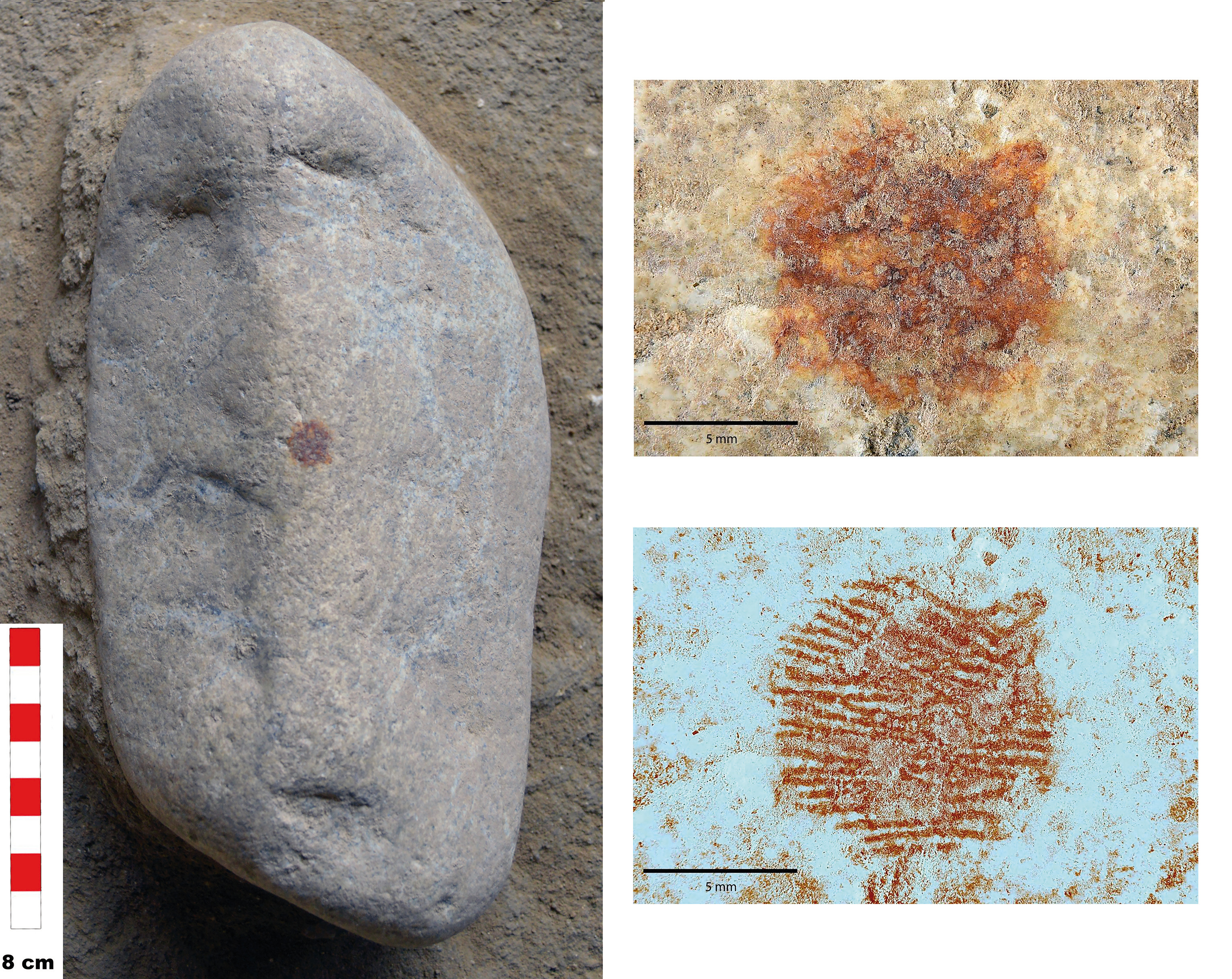Tracing the imprint of Neanderthal symbolic thought: a 43,000-year-old ochre fingerprint
Published in Social Sciences, Earth & Environment, and Arts & Humanities

At the end of May 2025, the journal Archaeological and Anthropological Sciences published the following article:
Álvarez-Alonso, D., de Andrés-Herrero, M., Díez-Herrero, A. et al. More than a fingerprint on a pebble: A pigment-marked object from San Lázaro rock-shelter in the context of Neanderthal symbolic behavior. Archaeol Anthropol Sci 17, 131 (2025). https://doi.org/10.1007/s12520-025-02243-1
This study presents a remarkable discovery that further expands our understanding of Neanderthal cognitive abilities: a painted piece of portable art, currently regarded as the oldest known example of its kind associated with Neanderthals. The object is a granite pebble onto which a red ochre dot was deliberately applied. Most notably, a fingerprint has been identified within the pigment—unequivocally attributed to a Neanderthal individual—making this find a direct and tangible trace of symbolic behaviour carried out more than 42,000 years ago.
The pebble was found at the San Lázaro rock-shelter, in the Eresma River valley (Segovia, Spain), within a Mousterian layer clearly associated with Neanderthal occupations, similar to those documented at nearby sites such as the Abrigo del Molino, and dated by AMS radiocarbon methods. Furthermore, it has been hypothesised that the object was deliberately selected for its natural morphology, which evokes a human face through the phenomenon of facial pareidolia. In this context, the application of red pigment may not only have enhanced that perception, but also served as a visual marker with symbolic significance. As such, the possibility that this represents an attempt to symbolise a human face adds an especially meaningful interpretative dimension to the find.
One of the most remarkable aspects of this research is the establishment of a collaborative investigation involving archaeologists, geologists, and a multidisciplinary approach that included the participation of experts from the Spanish National Police Forensic Science Department. Their contribution made it possible to identify the fingerprint with an unprecedented level of detail in a Palaeolithic context, positioning this work as a pioneering reference in the field of archaeology and forensic identification applied to prehistoric times. As such, the discovery not only provides new evidence of the Neanderthal symbolic world, but also opens up new avenues for exploring their artistic expression, visual sensitivity, and capacity for abstraction.
Reaching these conclusions required the application of a combination of techniques on the object. It was first documented in 3D using high-precision scanners and digital models, which helped to rule out any functional use. Subsequently, non-invasive analyses such as X-ray fluorescence and scanning electron microscopy confirmed that the red pigment was externally applied ochre, and not a natural component of the mineral. However, the most surprising breakthrough came from multispectral analysis—a well-established technique that was specifically developed for this context by the Spanish National Police Forensic Science Department. This revealed a fingerprint, invisible to the naked eye, located within the pigment itself.
The image was then analysed by identification specialists from the same forensic team, who confirmed its compatibility with a human fingerprint, identifying features such as epidermal ridges, bifurcations, and convergence points typical of human prints. Ultimately, the combined application of these scientific techniques not only reinforces the authenticity of the find, but also highlights its exceptional nature: this is one of the most complete physical testimonies to a symbolic act carried out by a Neanderthal, whose fingerprint was deliberately impressed into the pigment.
The origin of human symbolic behaviour—and with it, the emergence of art—remains one of the most debated questions in research on cognitive evolution. Although these two phenomena did not necessarily arise simultaneously, they are deeply interconnected, as symbolic capacity is the ultimate foundation of all forms of artistic expression. For decades, it was assumed that this ability was exclusive to Homo sapiens, but the development of new methodological approaches and the discovery of increasingly robust evidence have challenged, and ultimately overturned, that view. Today, there is growing consensus that Neanderthals also possessed a complex symbolic repertoire, expressed through modified objects, the use of pigments, symbolic behaviours, and other forms of conduct that are now interpreted as unequivocal expressions of symbolic thought.
One of the key milestones in this paradigm shift was the 2018 publication in the journal Science of the dating of several cave paintings discovered in three Spanish sites—Ardales, La Pasiega, and Maltravieso—which were attributed to Neanderthals.

These graphic expressions, including geometric shapes and recognisable patterns, revealed this human group’s ability to produce symbolic imagery imbued with intentionality and shared meaning, as the motifs—though simple—appear at different locations, suggesting a broader conceptual framework.
This is why this object adds to the growing body of archaeological evidence supporting the existence of cognitive capacities in Neanderthals comparable to those of Homo sapiens. A separate question is how such capacities were expressed, and whether what we call “art”—a form of expression with an undeniable communicative and social component—manifested differently in two human groups that were socially organised in distinct ways. It is likely that, within the context of isolation and strong endogamy experienced by many European Neanderthal groups, a conventionalised and widely shared symbolic system did not develop in the same way it did, progressively, in Homo sapiens. This unique and exceptional find reinforces the idea of Neanderthal symbolic capacity, emerging through experimentation with natural objects.
Follow the Topic
-
Archaeological and Anthropological Sciences

This is a journal that emphasizes natural scientific methods within archaeological contexts.
Related Collections
With Collections, you can get published faster and increase your visibility.
Characterizing technology, subsistence and settlement dynamics of the Middle Stone Age and Middle Paleolithic
Publishing Model: Hybrid
Deadline: Dec 31, 2025




Please sign in or register for FREE
If you are a registered user on Research Communities by Springer Nature, please sign in